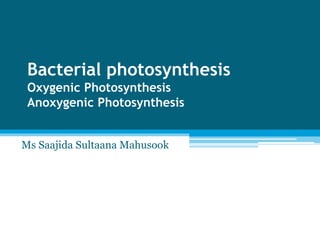
Photosynthesis in bacteria and its types
- 1. Bacterial photosynthesis Oxygenic Photosynthesis Anoxygenic Photosynthesis Ms Saajida Sultaana Mahusook
- 2. Photosynthesis • Photosynthesis is the conversion of light energy into chemical energy in the form of ATP. • Prokaryotes that can convert light energy into chemical energy include the photosynthetic cyanobacteria, the purple and green bacteria, halobacteria etc. • Net equation: 6CO 2 +12H2O+LightEnergy →C6H12O6+6O2+6H20
- 3. Photosynthetic reactions divided into two stages: Light reaction - light energy is absorbed and converted to chemical energy such as ATP and NADPH Dark reaction- carbohydrates made from CO2 is stored in ATP & NADPH • Photosynthetic bacteria contain light absorbing pigments and reaction centres and capable of converting light energy into chemical energy. • Photosynthetic pigments: Bacteriochlorophyll, carotenoids, bacteriorhodopsin, phycobilins.
- 4. Types of Bacterial photosynthesis Bacterial photosynthesis Oxygenic Photosynthesis Anoxygenic Photosynthesis
- 5. Oxygenic Photosynthesis • Oxygenic photosynthetic bacteria are unicellular or multicellular and possess Bacteriochlorophyll a. They perform photosynthesis in a similar manner to plants. • They contain light-harvesting pigments (such as phycobilins, phycoerythrin), absorb CO2, and release oxygen. Eg. Cyanobacteria or Cyanophyta and prochlorophytes . • The synthesis of carbohydrates results in release of molecular O2 and removal of CO2 from atmoshphere.
- 6. • It occurs in lamellae which house thylakoids containing chlorophyll a/b and phycobilisomes pigments to gather light energy. • This process involves two photosystems (PS): PS II- which generates a proton-motive force for making ATP. PS I- which generates low potential electrons for reducing power. • There are 5 sub groups of Oxygenic photosynthetic bacteria .
- 7. Different strains of Cyanobacteria
- 8. • Cyanobacteria perform photosynthesis using water as an electron donor in a similar manner to plants. This results in the production of oxygen and is known as oxygenic photosynthesis. • Cyanobacteria are often blue-green in color and are thought to have contributed to the biodiversity on Earth by helping to convert the Earth’s early oxygen- deficient atmosphere to an oxygen-rich environment. • Cyanobacteria are mostly found in water but can survive on land, in rocks, and even in animal shells (or fur), and in coral. They are also endosymbiont- they can live within the cells or body of another organism in a mutually beneficial way.
- 9. Anoxygenic Photosynthesis • Anoxygenic photosynthetic bacteria consume CO2, light energy to create organic compounds, sulfur or fumarate compounds instead of O2. • It occurs in purple bacteria, green sulfur bacteria, green gliding bacteria, Filamentous Anoxygenic Phototrophs (FAPs), Phototrophic Acidobacteria, and Phototrophic Heliobacteria. • It uses bacteriochlorophyll instead of chlorophyll and involves one photosystem (PS I) to generate ATP in “cyclic” manner.
- 10. • Purple bacteria can be divided into two main types – the Chromatiaceae, which produce sulfur particles inside their cells, and the Ectothiorhodospiraceae, which produce sulphur particles outside their cells. • They cannot photosynthesize in places that have an abundance of oxygen. They are found in either stagnant water or hot sulfuric springs. • Purple sulfur bacteria use hydrogen sulfide as their reducing agent(instead of using water to photosynthesize), releasing sulfur (rather than oxygen).
- 11. Purple non-sulfur bacteria use hydrogen as their reducing agent, do not release sulphur. • They can tolerate small amounts of sulfur, and too much hydrogen sulfide is toxic to them. Green sulfur bacteria are generally non-motile and occurs in multiple shapes such as spheres, rods, and spirals. • They are found in deep ocean and can survive in extreme conditions, like the other types of photosynthetic bacteria.
- 12. Phototrophic Acidobacteria are found in a lot of soils. Some are acidophilic . Phototrophic Heliobacteria are found in soils, especially water-saturated fields, like rice paddies. They use bacteriochlorophyll g. • They are photoheterotroph- they cannot use carbon dioxide as their primary source of carbon.
- 13. Green and red filamentous anoxygenic phototrophs (FAPs) were previously called green non-sulfur bacteria, until it was discovered that they could also use sulfur components to work through their processes. • This type of bacteria uses filaments to move around. The colour depends on the type of bacteriochlorophyll the particular organism uses. • This bacteria can either be photoautotrophic chemoorganotropic or photoheterotrophic.
- 14. Applications of Photosynthetic Bacteria • Water purification, bio-fertilizers, animal feed and bioremediation of chemicals among many others. • They are used in the treatment of polluted water since they can grow and utilize toxic substances such as H2S or H2S203. • Researchers at Harvard’s Wyss Institute have engineered photosynthetic bacteria to produce simple sugars and lactic acid.
- 15. References: • https://courses.lumenlearning.com/microbiolog y/chapter/photosynthesis/ • https://nptel.ac.in/courses/102103015/21 • https://photosynthesiseducation.com/photosynt hesis-in-bacteria/
- 16. Thank you